Top Rankings
Rapid City Area School District 51-4 ranks among the top 20% of public school district in South Dakota for:
Category
Attribute
Diversity
Most diverse schools (Top 1%)
Community Size
Largest student body (number of students) (Top 1%)
For the 2025 school year, there are 8 public middle schools serving 2,923 students in Rapid City Area School District 51-4. This district's average middle testing ranking is 4/10, which is in the bottom 50% of public middle schools in South Dakota.
Public Middle Schools in Rapid City Area School District 51-4 have an average math proficiency score of 36% (versus the South Dakota public middle school average of 39%), and reading proficiency score of 46% (versus the 49% statewide average).
Minority enrollment is 42% of the student body (majority American Indian), which is equal to the South Dakota public middle school average of 42% (majority American Indian).
Overview
This School District
This State (SD)
# Schools
29 Schools
297 Schools
# Students
12,485 Students
40,141 Students
# Teachers
802 Teachers
2,999 Teachers
Student : Teacher Ratio
16:1
16:1
District Rank
Rapid City Area School District 51-4, which is ranked within the bottom 50% of all 146 school districts in South Dakota (based off of combined math and reading proficiency testing data) for the 2021-2022 school year.
The school district's graduation rate of 70% has decreased from 75% over five school years.
Overall District Rank
#109 out of 148 school districts
(Bottom 50%)
(Bottom 50%)
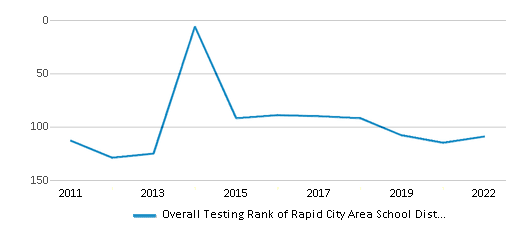
Math Test Scores (% Proficient)
36%
42%
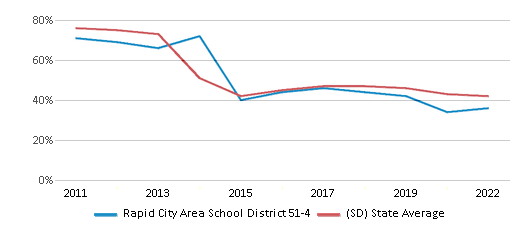
Reading/Language Arts Test Scores (% Proficient)
46%
51%
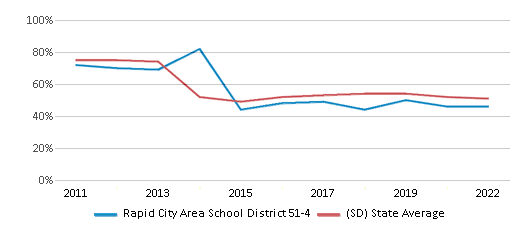
Science Test Scores (% Proficient)
38%
42%
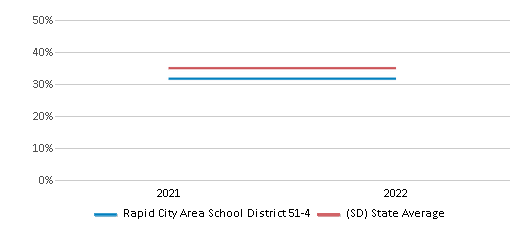
Graduation Rate
70%
82%
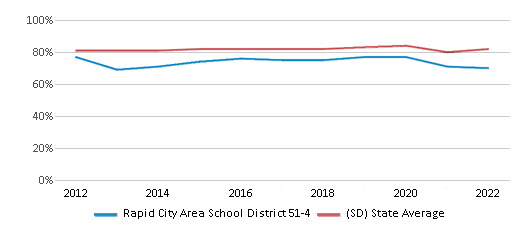
Students by Ethnicity:
Diversity Score
0.60
0.59
# American Indian Students
2,069 Students
10,455 Students
% American Indian Students
17%
26%
# Asian Students
155 Students
519 Students
% Asian Students
1%
1%
# Hispanic Students
1,272 Students
2,703 Students
% Hispanic Students
10%
7%
# Black Students
127 Students
1,024 Students
% Black Students
1%
3%
# White Students
7,396 Students
23,358 Students
% White Students
59%
58%
# Hawaiian Students
10 Students
46 Students
% Hawaiian Students
n/a
n/a
# Two or more races Students
1,456 Students
2,036 Students
% of Two or more races Students
12%
5%
Students by Grade:
# Students in PK Grade:
96
174
# Students in K Grade:
902
896
# Students in 1st Grade:
888
903
# Students in 2nd Grade:
986
918
# Students in 3rd Grade:
910
750
# Students in 4th Grade:
925
793
# Students in 5th Grade:
1,011
1,598
# Students in 6th Grade:
967
9,664
# Students in 7th Grade:
910
11,058
# Students in 8th Grade:
1,003
11,237
# Students in 9th Grade:
1,253
674
# Students in 10th Grade:
982
578
# Students in 11th Grade:
867
481
# Students in 12th Grade:
785
417
# Ungraded Students:
-
-
District Revenue and Spending
The revenue/student of $12,642 in this school district is less than the state median of $13,121. The school district revenue/student has stayed relatively flat over four school years.
The school district's spending/student of $11,662 is less than the state median of $12,623. The school district spending/student has stayed relatively flat over four school years.
Total Revenue
$158 MM
$1,916 MM
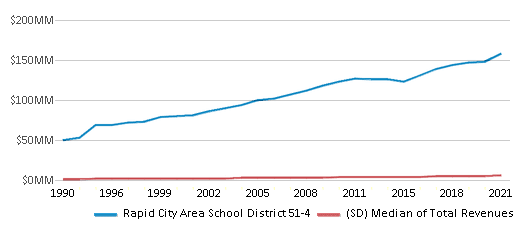
Spending
$146 MM
$1,844 MM
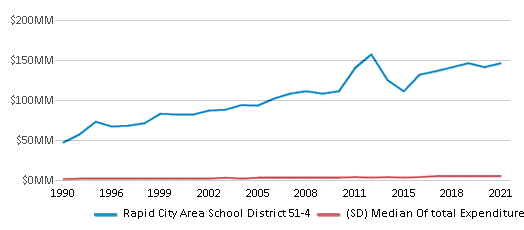
Revenue / Student
$12,642
$13,121
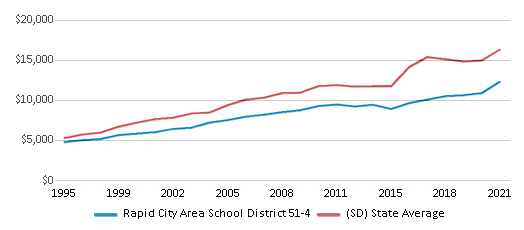
Spending / Student
$11,662
$12,623
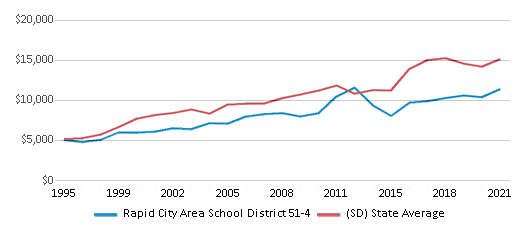
Best Rapid City Area School District 51-4 Public Middle Schools (2025)
School
(Math and Reading Proficiency)
(Math and Reading Proficiency)
Location
Grades
Students
Rank: #11.
Southwest Middle School - 38
(Math: 59% | Reading: 70%)
Rank:
Rank:
10/
Top 10%10
4501 Park Dr
Rapid City, SD 57702
(605) 394-6792
Rapid City, SD 57702
(605) 394-6792
Grades: 6-8
| 665 students
Rank: #22.
Rapid City Online Middle School - 93
(Math: <50% | Reading: ≥50%)
Rank:
Rank:
7/
Top 50%10
625 9th St Ste 208
Rapid City, SD 57701
(605) 394-4067
Rapid City, SD 57701
(605) 394-4067
Grades: 6-8
| 16 students
Rank: #33.
West Middle School - 37
(Math: 43% | Reading: 53%)
Rank:
Rank:
5/
Bottom 50%10
1003 Soo San Dr
Rapid City, SD 57702
(605) 394-4033
Rapid City, SD 57702
(605) 394-4033
Grades: 6-8
| 603 students
Rank: #44.
East Middle School - 30
(Math: 32% | Reading: 41%)
Rank:
Rank:
2/
Bottom 50%10
4860 Homestead St
Rapid City, SD 57703
(605) 394-4092
Rapid City, SD 57703
(605) 394-4092
Grades: 6-8
| 611 students
Rank: #55.
South Middle School - 36
(Math: 24% | Reading: 37%)
Rank:
Rank:
2/
Bottom 50%10
2 Indiana St
Rapid City, SD 57701
(605) 394-4024
Rapid City, SD 57701
(605) 394-4024
Grades: 6-8
| 502 students
Rank: #66.
North Middle School - 35
(Math: 16% | Reading: 25%)
Rank:
Rank:
1/
Bottom 50%10
1501 N Maple St
Rapid City, SD 57701
(605) 394-4042
Rapid City, SD 57701
(605) 394-4042
Grades: 6-8
| 480 students
Rank: #77.
Jefferson Building - 64
Special Education School
(Math: 25-29% | Reading: 45-49% )
Rank:
Rank:
1/
Bottom 50%10
21 St Joseph St
Rapid City, SD 57701
(605) 394-1813
Rapid City, SD 57701
(605) 394-1813
Grades: PK-12
| 35 students
Rank: n/an/a
Wellfully - 65
Alternative School
22 Waterloo St
Rapid City, SD 57701
(605) 394-4048
Rapid City, SD 57701
(605) 394-4048
Grades: 1-12
| 11 students
Recent Articles
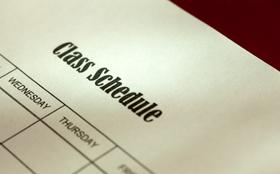
Year-Round Or Traditional Schedule?
Which is more appropriate for your child? A year-round attendance schedule or traditional schedule? We look at the pros and cons.

Why You Should Encourage Your Child to Join a Sports Team
Participating in team sports has a great many benefits for children, there is no doubt. In this article you will learn what those benefits are.

White Students are Now the Minority in U.S. Public Schools
Increasing birth rates among immigrant families from Asia and Central and South America, combined with lower birth rates among white families, means that for the first time in history, public school students in the United States are majority-minority. This shift in demographics poses difficulties for schools as they work to accommodate children of varying language abilities and socio-economic backgrounds.





